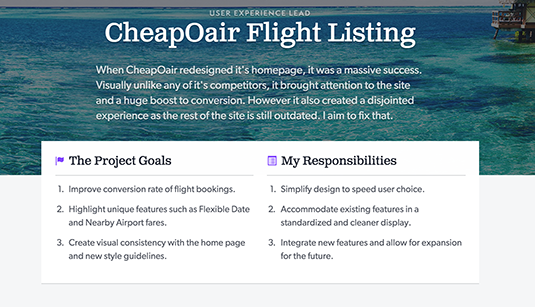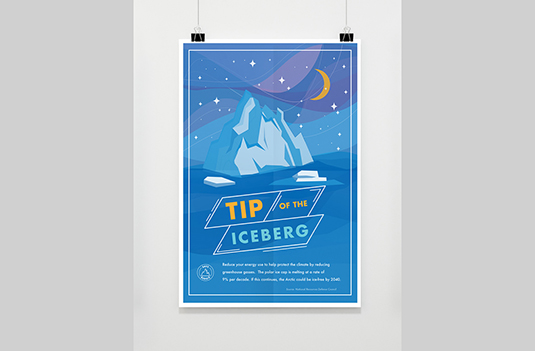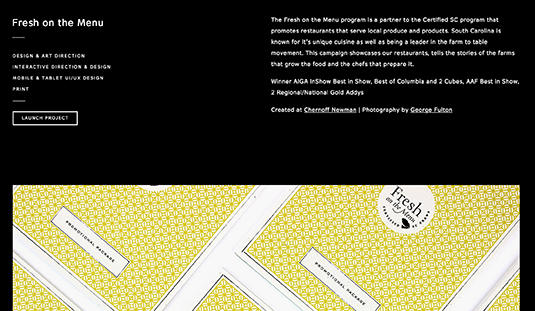3 keys to a killer freelance design portfolio
Having a complete and descriptive online portfolio is a great way to get inbound work requests.
It's easy to create a portfolio, but difficult to create an awesome portfolio. Most designers will just put up a couple of screenshots of their flashiest works, add a mailto link, and call it a day.
However, putting a little thought into your portfolio can go a long way. Your portfolio's purpose isn't to look great to other designers, it's to get clients to reach out to you. It also helps to remember that clients aren't coming to you for an illustration or logo or landing page. They're coming to you to solve a problem they have, and they're often not designers themselves.
Here are three foundations of an awesome portfolio that'll win you clients.
01. Explain the context (goals and constraints) of each project

For clients to evaluate your work, they must know what the client asked you to do in the first place. Prospective clients put themselves in the shoes of your past clients, and want see if you'll get them the same results. By explaining what objectives and constraints you had in past projects, you'll better equip prospective clients to do this.
Jim Silverman does an awesome job explaining for each of his projects what a client wanted him to accomplish, and what his responsibilities were.
02. Talk about your process

Don't just show screenshots without context. Clients want to know how you think and will approach their problem. They're not hiring you for some JPG or HTML files, they're hiring you to help solve a problem.
Alexa Stefanou talks about how she used humor and a non-conventional approach to make the issue of climate change more poignant in the 'Save Bergie' project.
Daily design news, reviews, how-tos and more, as picked by the editors.
"I believe that one reason progress stalls is because the solution seems overwhelming or even impossible. In the case of climate change, there is a lot of work that has to be done – but it can't happen all at once. The first step is to teach people what the issue is, then guide them to steps they are able to take to improve the situation.
"The project uses a playful illustration style to draw people in. A pun is involved because, in my opinion, puns are pretty much perfect. Having an additional playful element is a great way to keep the idea stuck in people's minds. The more people connect to an issue, the more likely they are to contribute to supporting it."
03. Show your value

The key thing to remember is that clients aren't hiring you to design, they're hiring you to solve a problem. So remember to mention how your work helped a client.
For example, you could say, after launching, my client acquired 100,000 sign ups on the landing page I built, improved their user retention by 55 per cent and increased revenue by 20 per cent, or won some best-in-class award. The client will think that, if you had a concrete benefit for someone else, you can do the same for them.
Harrison Croft does an excellent job of explaining the background behind this project, as well as validates the quality of his work with the awards it won.
These aren't complicated things to add, but will go a long way in showing your expertise as a designer!
Words: Matt Brown
Matt Brown is the co-founder of Bonsai, which provides bulletproof contracts for freelance designers.
Liked this? Read these!
- How to make web forms work better on mobile
- Discover the best blogging platform
- The best free script fonts

The Creative Bloq team is made up of a group of art and design enthusiasts, and has changed and evolved since Creative Bloq began back in 2012. The current website team consists of eight full-time members of staff: Editor Georgia Coggan, Deputy Editor Rosie Hilder, Ecommerce Editor Beren Neale, Senior News Editor Daniel Piper, Editor, Digital Art and 3D Ian Dean, Tech Reviews Editor Erlingur Einarsson, Ecommerce Writer Beth Nicholls and Staff Writer Natalie Fear, as well as a roster of freelancers from around the world. The ImagineFX magazine team also pitch in, ensuring that content from leading digital art publication ImagineFX is represented on Creative Bloq.
